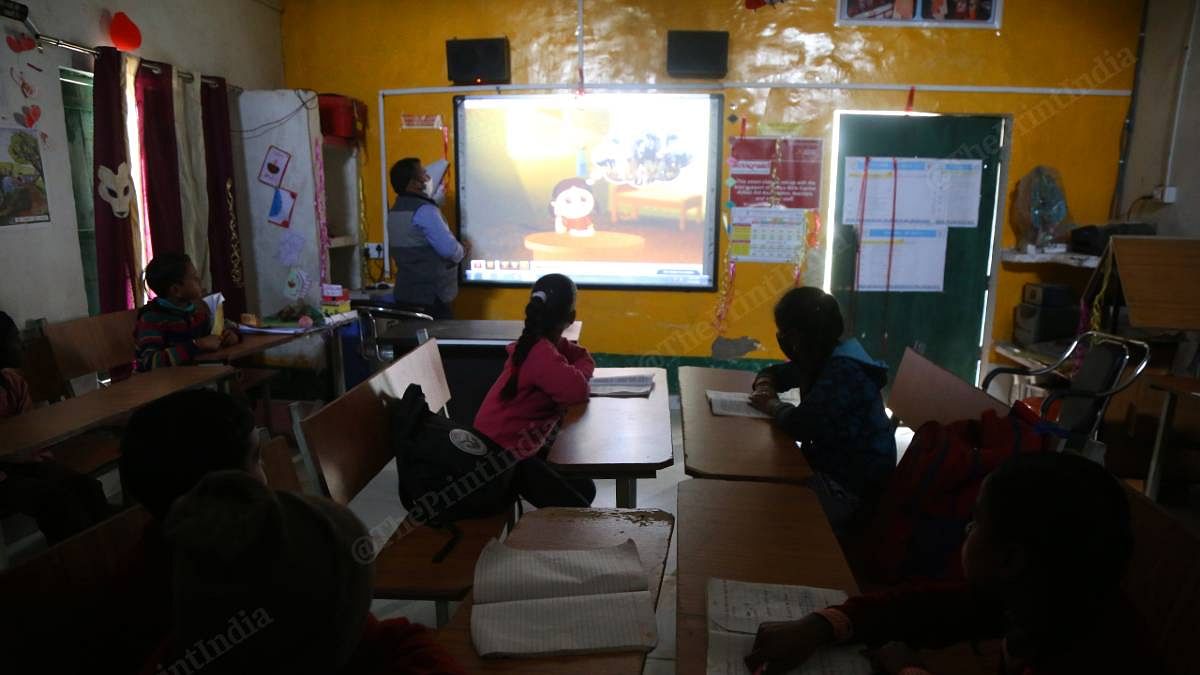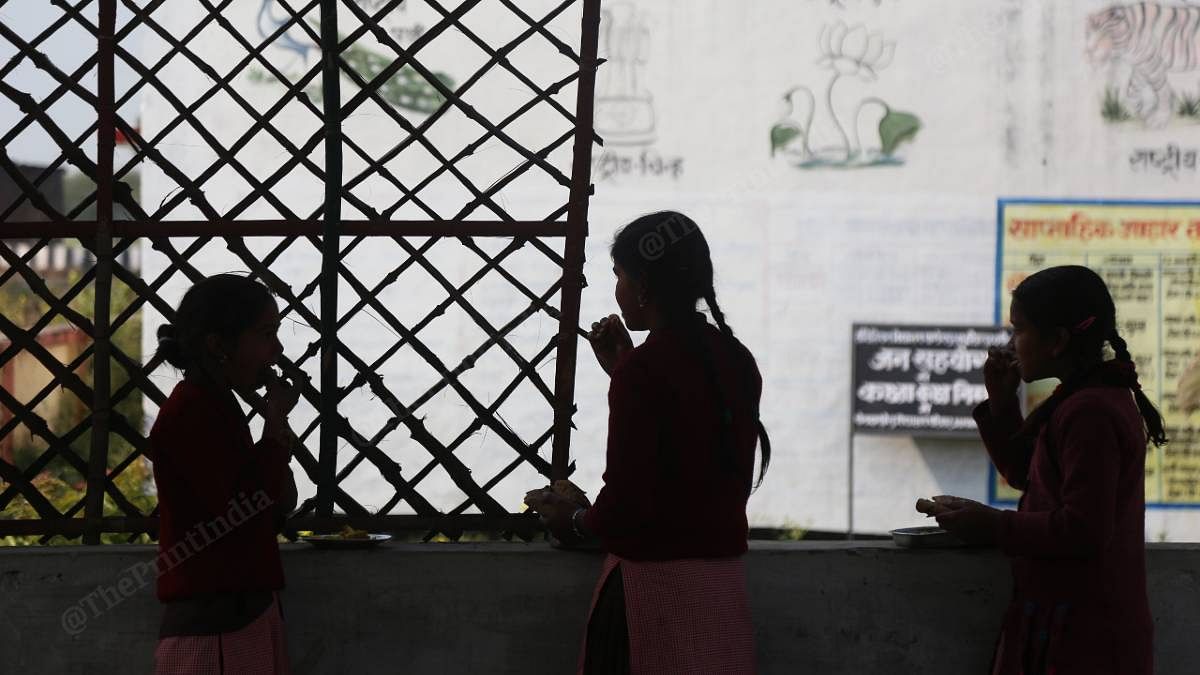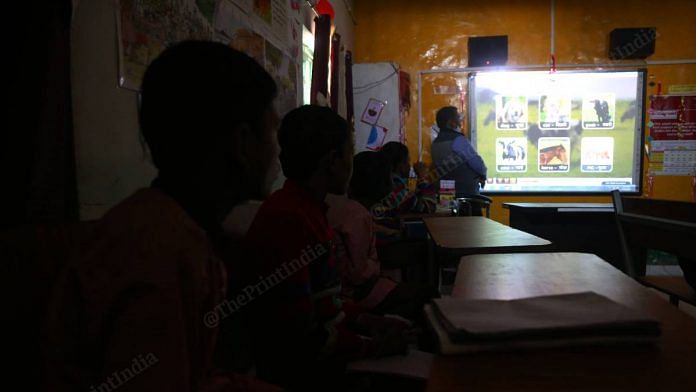Shravasti: A bunch of students, most of them in uniform, sit huddled in a classroom, eyes glued to a projector on the wall, where pictures of different animals are being displayed. A voiceover accompanies the visual presentation, describing the animal and its habitat in great detail.
While it may seem like another digital, smart class to people in a metro city or one of India’s tier-I towns, this is actually a glimpse of a classroom at the Government Upper Primary School in Pandey Purwa village in Hariharpur Rani block, in Uttar Pradesh’s Shravasti district.

The school has about 350 students, mostly from poor families, from the 10 surrounding villages, in a radius of 1.5-2.5 km. Smart classes, where audio-visual aids like projectors and smart boards are used in teaching, is the USP here.
This might come as a surprise, since Shravasti is India’s poorest district, according to a NITI Aayog report on the national Multi-Dimensional Poverty Index (MDI), published last year. About 74.38 per cent of the population deemed to be “multidimensionally poor”, according to the report, based on 2015-16 data from the National Family Health Survey (NFHS)-4.
Since the NFHS-4 period, Shravasti, has improved on certain parameters of maternal and child health, literacy, electricity coverage. But experts say there is need for more.
And so, some passionate young officers and teachers from the district are trying to bring in development in education, slowly trying to usher in change and turn things around, by coming up with innovative learning models in the field of primary education.
These initiatives, small as they are, have given the district’s poor families and especially their children, hope of a better future, where they won’t have to drop out of school and go looking for jobs wherever in the country they may find them.
Condition of school education
Physical classes resumed in Shravasti last week, after being suspended for 45 days during the third Covid wave earlier this year.
The district has 1,280 government-run primary and upper-primary schools. But changes, such as smart classes, have come only in small isolated pockets, and are not getting scaled up fast across other schools, especially those in rural belts across the district, say locals and NGOs working in the area.
District officials also admit to other challenges — student-teacher ratio is poor, says an official who does not want to be named.
There are many instances of single-teacher schools. In many others, especially those in remote areas, teachers do not come regularly to schools, officials say.
“This has resulted in gaps in learning. The children who come from very poor households lose interest. Many just stop coming to schools altogether,” says a teacher in one of the primary schools in Shravasti, on the condition of anonymity.

But officials claim that at least a beginning has been made in introducing innovative education techniques in the district, where close to half the population is not literate, according to the National Family Health Survey-4 (2015-16) data. While 32.7 per cent women in the district were literate then, the figure was 53.2 per cent for men. The district’s literacy figures are even far below the overall statistics for Uttar Pradesh — 61 per cent women and 82.4 per cent men are literate in the state.
According to Census 2011, average literacy rate in Shravasti is 46.74 per cent. While the enrolment is 100 per cent in primary and upper primary level (till Class 8), approximately 43 per cent children in the district drop out after Class 8.
Also read: Can’t learn, can’t work, can’t even cross river: Life in 3 of India’s 4 poorest districts, all in UP
Started with one teacher and his laptop
In such a scenario, new teaching methods, such as the adoption of smart classes in primary and upper primary schools, is a welcome step.
The Government Upper Primary Model School in Pandey Purwa, mentioned above, was the first in Shravasti district to go smart in 2018.
It started with Anurag Pandey, the head teacher, after he got transferred here from another primary school in the district.
Back then, there were some 150 children studying in the school, and attendance used to be erratic. Pandey, a PhD from the Banaras Hindu University, started by bringing his own laptop to school and using it to teach a small groups of students. But it was too small an intervention to make a difference.

He then reached out to some corporates to donate projectors, smart screens and audio-visual aids to the school, as part of their Corporate Social Responsibility (CSR). A few of them responded. With an investment of Rs 1.5 lakh from the corporates, the smart classes began, says Pandey.
Three-and-a half years later, the Pandey Purwa model school has become a shining example in the district of how learning can be made interesting for children.
“Bachche achhe se samajh kar seekh rahe hain (the students now understand the lesson well and are learning). Children studying here now look forward to coming to school,” says Shakuntala Pal, 38, one of the teachers posted at the school.
Pal, who has a master’s degree in science from Bareilly’s Rohilkhand University, said the head teacher and eight other teachers in the school had to do a lot of community mobilisation initially. “We made parents participate in meetings in the school and convinced them. Parents earlier did not want to send children to study,” she says.
Enrolment has now gone up in the school — from just 150 students three years back, to 350 now, and there are no dropouts, said school authorities.
There is also a marked improvement in the cognitive ability of children studying here despite the disruption caused by Covid, says head teacher Pandey.
“Most of these kids had limited reading and writing abilities when I came here in 2018.The enrollment was poor and drop out rate high. It was a task to make them read a paragraph in English. Today, a majority of them can confidently read a full chapter at one go,” he adds.
Also read: Code red on malnutrition: Why half the kids in 3 poorest UP districts are stunted, many ‘wasted’
Role model for the district
Impressed with the school’s performance, the district administration launched ‘Project Saksham’ in 2020-21, on a pilot basis. In the first phase, 25 smart classes are being set up at a cost of Rs 82.17 lakh.
The figures might look like a drop in the ocean in a district with 1,280 government-run primary and upper primary schools, but district administration officials are hopeful of scaling it up quickly.
“Under Saksham, around 50 per cent of the primary schools in the district will be converted to smart schools,” says Ishan Pratap Singh, Shravasti’s chief development officer.
Meanwhile, having already made a start, the Pandey Purwa model school has been tackling other challenges, the biggest being the pandemic.
“When schools went online, we had to follow up individually with each student, as just about 10 per cent of the children had mobile phones,” says Pandey.
However, there are other still challenges due to the backwardness of the district.
“Erratic power supply is a big irritant. There have been so many times when we have switched on the projector to show something to the students and suddenly the power conks off… that’s why we can’t use it regularly,” he adds.
(Edited by Poulomi Banerjee)
Also read: 3 of India’s 4 poorest districts are ‘money order economy’, survival means going away from UP



